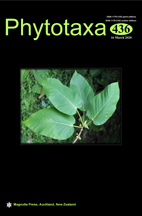Abstract
Cystoliths are microscopic calcium deposits found remarkably in some genera and is of key importance to understand its taxonomic value. Leaf samples of 19 species belonging to 7 sections of Indian Ficus were processed for anatomical studies and surface micromorphological characteristics of cystoliths. The morphology, distribution and sculpture patterns of cystolith found varying among species. Four types of basic sculpturing patterns have been observed in this study: aculeate, colliculate, verrucate, and tuberculate. The aculeate sculpturing pattern is the most common type observed in twelve species of section Cordifoliae, but further division of this pattern into three subtypes i.e. broad, moderate and reduced aculeate along with the length and width of cystoliths appendages and the mode of stalk fixation provides more informative insight into sub-sectional classification. Principal component analysis (PCA) provides a supporting evidence for earlier classification at sectional/subsectional level. Though in few cases it has not support the decision taken by molecular studies. This study suggests that cystolith micromorphological characters could be utilized in the re-classification of Ficus taxa at sub-sectional level.

